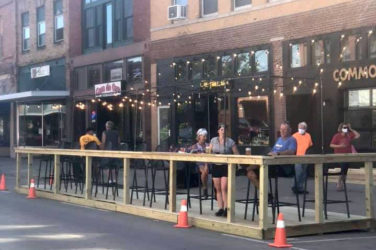
Written by Gary McKay
[dropcap]S[/dropcap]mart and assured. A writer of exemplary prose. Handsome, fit and flawlessly turned out. The canny creator of a successful career. Husband to an accomplished child psychiatrist and father of two young sons. Raynard Kington, who since August 2010 has served as Grinnell College’s president, cuts a rare figure in Iowa—but then, he’d do that anywhere.
Kington, 52, enters the third year of his job at a time when the position of college president is anything but securely leather-bound and ivy-clad. He’ll need all his gifts to assure Grinnell’s continued significance among American colleges. The school, though highly ranked and enviably funded, is small, with about 1,600 students, and sits nowhere near a big, culturally faceted city. Plus, since its founding in 1846, Grinnell has devoted itself exclusively to the liberal arts, a broad curriculum now sometimes criticized as pricey and impractical in our tech-centric times.
Kington has yet to author a tome on Whither Doth the Liberal Arts Find Refuge. However, hearing him talk about his plans to strengthen and promote Grinnell College (see story, page 150) often convinces listeners that his ideas are more sensible than many of the scholars’ schemes debated in The New York Review of Books.
In fact, Kington’s sharpness and confidence sway audiences no matter what his subject. Whether he’s responding to alumni assessments of their Midwestern educations or fielding interview questions, Kington swiftly synthesizes “the multiple dimensions of a topic in clear and concise terms,” observes Paul Risser, vice chair of Grinnell’s board of trustees. Kington’s style, he says, “automatically raises the quality of the discussion, because all the participants feel an inevitable need to match the level of his discourse.”
Kington leaps at every day’s challenges so fearlessly, and sorts out complex issues so quickly, that he can personally, physically, come off as a bit of a blur. Outside his office, he darts around the compact town of Grinnell on a shiny red bike. Inside, he greets everyone heartily, deals with the business at hand and then, precisely, adamantly on schedule, presses forward.
That ability to press forward appears to be a family trait. Kington’s great-grandparents on his mother’s side were slaves in Texas. Given their freedom by the Emancipation Proclamation and some property by their former owner, they flourished. His Jamaican father traveled by ship to the United States in 1924, attended medical school and became a physician in Baltimore, Kington’s hometown.
A brilliant child, Kington went to kindergarten at age 4 and the University of Michigan at 16. By age 21, he’d earned a medical degree; afterward, he quickly collected an M.B.A. and a doctorate in health policy and economics at the University of Pennsylvania’s Wharton School. His impressive research skills garnered attention during stretches of employment with the Centers for Disease Control and Prevention and the Rand Corp. In 2000 he signed on at the National Institutes of Health (NIH) in Bethesda, Md.
Kington rose to prominence there, and not just for the careful, focused way he gathered information. During a stint as chief ethics officer, he dealt with the public reverberations of a scandal involving NIH scientists who had cut shady consulting deals with pharmaceutical companies.

Then, after a promotion to acting director, he was told he’d have to allocate a federal stimulus of $10 billion alongside the NIH’s yearly $30 billion budget—within a nerve-wracking brief nine months. To limit risk, Kington adopted unusually stringent spending guidelines. He collected experts (and took their counsel to heart), broadcast a need-it-yesterday request for grant applications and began to divvy up his dauntingly heavy bags of coin.
Dr. Francis Collins, the NIH’s current director, says Kington got stuck with “all sorts of unpleasant tasks relating to personnel issues, resolving disputes and untangling administrative snarls. He did so with grace and an unfailing sense of humor. … After my arrival in August 2009, Raynard was an incredibly valuable source of wise advice and institutional knowledge. He never steered me wrong.” Collins became enamored of Kington’s “unflappable” management style to the point where, as he now admits, “For completely selfish reasons, I tried to talk him out of the decision to take the presidency of Grinnell, but it was clear he had found his next calling.”
Kington’s resume and character persuaded Grinnell’s trustees to unanimously choose him as the school’s president, from a stack of at least 200 applications. Famously, his bags were delayed when he flew to Iowa to introduce himself to Grinnell’s search committee. The night before that crucial appointment, he bought new interview clothes at Wal-Mart.
As an illustration of what he describes as Kington’s “intensity,” Risser notes that, after vacating the controversy-fraught position at the NIH, “most of us would have taken off for a few weeks of transition. Not Raynard. He left his position as deputy director of NIH at 5 p.m. on Friday, Aug. 20, 2010, and caught a 6 a.m. flight from Washington, D.C., to Iowa the next day—just so he could participate in the formal ceremony welcoming the incoming class of 2014.” Because Kington was determined to “meet and get to know Grinnell alumni,” Risser adds, the energetic newbie journeyed to 31 separate events and met more than 2,000 graduates within a year.
When in Grinnell, Kington works in an office overflowing with keepsakes and a chunk of his library. Angela Voos, special assistant to the president, acknowledges that his modest, squarish work space is initially overwhelming: “He’s a constant reader. There are books and journals and reports and notebooks everywhere.”
As visitors grow accustomed to Kington’s heaps, they might spy a copy of Seamus Heaney’s “The Cure at Troy: A Version of Sophocles’ Philoctetes” resting next to his phone. Volumes on the history of Korea are piled on his conference table; Grinnell professor Sarah Purcell’s book, “Sealed With Blood: War, Sacrifice and Memory in Revolutionary America,” balances precariously atop a motley stack on his desk.
From the CD player tucked behind Kington’s computer screens, drop-ins catch Maria Callas performing “Madame Butterfly” or Morris Robinson singing “Going Home.” Kington sets out framed photographs of his family—his sons, Emerson, 6, and Basil, 3, in a hammock, and his husband, Peter Daniolos, cradling one of the boys as a baby. On a shelf, a weathered sign is lettered with his father’s name, “Dr. G.D. Kington, Physician.”
Temporarily, a folding picnic table leans against a corner wall of his office. “Raynard cooks and bakes, and he’s been talking about preparing the perfect picnic,” Voos says. “I know it includes fried chicken, biscuits, a salad—he was still deciding on one last time I heard—plus iced tea and pie.”
Anyone acquainted with Kington will confirm how brightly he glows at any mention of his family, as well as his foodie inclinations. Kington says he misses the dozens of ethnic restaurants tucked along side streets in Washington, D.C., and wishes he could introduce his kids to fondly remembered dishes like the Jamaican chicken his father craved. Aside from the loss of those fragrant eateries, he’ll confess to no regrets about leaving the East Coast for the cornfields that only briefly pause to accommodate Grinnell. “We have a totally intact downtown here,” he says, “with a bookstore, a movie theater, a bakery and a grocery store close by.”
Fortunately, the mid-20th-century, ranch-style house Grinnell maintains for its presidents features an efficient kitchen. There, after tracking down ingredients, Kington fixes his repertoire of Chinese specialties. Kington and Daniolos furnished their place with contemporary yet reassuringly neutral pieces. Their living room could be lifted from, say, a W Hotel suite, or a spread in a Design Within Reach catalog.
As does any parent of scampering, hopping, ball-flinging little boys, Kington is gradually realizing that not every sleek chair or sofa in his house will survive Emerson and Basil’s childhood. On the late-July afternoon when Kington, Daniolos and their sons assembled for their photograph (page 149), the boys posed sweetly for 20 minutes in laundry-fresh polo shirts, then rocketed off to play. Basil headed toward a set of four swiveling armchairs on chrome pedestals; plainly, he regarded them as his own tot-scaled Tilt-A-Whirl. The chairs, Kington says ruefully, are upholstered in an oatmeal-colored cashmere that suffers in silence.
Despite agreeing to a family photograph for ia magazine, Kington is a private, protective father and husband. Patricia Finkelman, a 1980 Grinnell graduate who’s now on the college’s board of trustees, reveals that before Kington committed his family to the president’s house, “he expressed some reservations about the fishbowl effect of living in a small town. As an example, he asked, ‘What happens when one of the boys has a meltdown at Whole Foods, and everybody recognizes us?’ I didn’t have the heart to tell him that since there was no Whole Foods, that was a scenario he wouldn’t have to worry about. It’s my sense that he and Peter and the boys have become an integral and welcome addition to the Grinnell community, in spite of any public tears or tantrums.”
As she recollects her travels with Kington, Finkelman lights on another memory that amuses her: “I traveled with him and a few other Grinnell representatives to one of the cities he visited for meetings with alumni and parents. After a well-received presentation to a large group and a smaller dinner with donors, we stopped in the gift shop on the way out of the restaurant to buy stuffed animals for his kids. I can still picture him there, debating the virtues of stuffed pigs versus bears, and the relative softness of each.”
Loyal to Liberal Arts

Photo by Daniel Strong.
Wherever he appears, whomever he confronts, Grinnell College President Raynard Kington fights loyally for the value and relevance of that school’s degrees in liberal arts. Curtly dismissing the too-specific skill sets packaged by business and technical colleges, he maintains that “an understanding of the natural world, of the human condition, of our responsibilities to society” more protectively and flexibly equips young people for whatever paths they later explore.
To reinforce and, he hopes, enhance Grinnell’s reputation and influence, Kington is burnishing the college’s image—its “brand.” The school’s efforts to engage a wider swath of today’s brainy, college-shopping high schoolers include ditching Grinnell’s current, somewhat creaky website for a livelier, more interactive one. Alumni are being summoned to aid in student recruitment by visiting with prospects and, Kington says, “telling them our story—articulating what we think sets us apart.” Grinnell further encourages its alumni who are employed in the private sector to hire recent graduates for internships, if possible, as a demonstration to freshman classes that there’s a paycheck, however modest, awaiting them four years on.
Outlining his notions for improving the quality and diversity of Grinnell’s student body, Kington pauses to congratulate the school for the number of foreign students it’s garnered, especially given its location far from international gateway airports. He believes less attention has been paid lately to local recruitment, and he means to rectify that. “Historically, Grinnell enrolled Iowa’s best and brightest,” he says. “We’ll get there again.”
Like many other incoming managers of old-line establishments’ funds, Kington senses an urgent need to raise them. (In recessionary times, no institution can be too rich or too thinly indebted.) And for extra money, he charges once more into Grinnell’s ranks of alumni. A financial overview he published in The Grinnell Magazine aims sharply at his target audience. “It has almost been taboo,” he wrote, “to talk about raising money at Grinnell.” Kington intends to invest in fund-raising campaigns, staff them sufficiently and trumpet giving as “a cultural value” among his school’s alumni.





Show Comments (1)
Nancy Rawles
Fabulous article. I wanted to read about the college that requested an investigation to determine whether or not it had handled allegations of sexual harassment properly. I figured it must have a mighty special person at the helm. I see I was right.
Comments are closed.